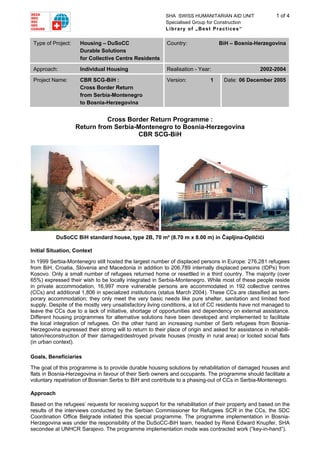
SHA SWISS HUMANITARIAN AID HOUSING PROJECT
- 1. SHA SWISS HUMANITARIAN AID UNIT 1 of 4 Specialised Group for Construction Library of „Best Practices“ Type of Project: Housing – DuSoCC Durable Solutions for Collective Centre Residents Country: BiH – Bosnia-Herzegovina Approach: Individual Housing Realisation - Year: 2002-2004 Project Name: CBR SCG-BiH : Cross Border Return from Serbia-Montenegro to Bosnia-Herzegovina Version: 1 Date: 06 December 2005 Cross Border Return Programme : Return from Serbia-Montenegro to Bosnia-Herzegovina CBR SCG-BiH DuSoCC BiH standard house, type 2B, 70 m² (8.70 m x 8.00 m) in Čapljina-Opličići Initial Situation, Context In 1999 Serbia-Montenegro still hosted the largest number of displaced persons in Europe: 276,281 refugees from BiH, Croatia, Slovenia and Macedonia in addition to 206,789 internally displaced persons (IDPs) from Kosovo. Only a small number of refugees returned home or resettled in a third country. The majority (over 65%) expressed their wish to be locally integrated in Serbia-Montenegro. While most of these people reside in private accommodation, 16,997 more vulnerable persons are accommodated in 192 collective centres (CCs) and additional 1,806 in specialized institutions (status March 2004). These CCs are classified as tem- porary accommodation; they only meet the very basic needs like pure shelter, sanitation and limited food supply. Despite of the mostly very unsatisfactory living conditions, a lot of CC residents have not managed to leave the CCs due to a lack of initiative, shortage of opportunities and dependency on external assistance. Different housing programmes for alternative solutions have been developed and implemented to facilitate the local integration of refugees. On the other hand an increasing number of Serb refugees from Bosnia- Herzegovina expressed their strong will to return to their place of origin and asked for assistance in rehabili- tation/reconstruction of their damaged/destroyed private houses (mostly in rural area) or looted social flats (in urban context). Goals, Beneficiaries The goal of this programme is to provide durable housing solutions by rehabilitation of damaged houses and flats in Bosnia-Herzegovina in favour of their Serb owners and occupants. The programme should facilitate a voluntary repatriation of Bosnian Serbs to BiH and contribute to a phasing-out of CCs in Serbia-Montenegro. Approach Based on the refugees’ requests for receiving support for the rehabilitation of their property and based on the results of the interviews conducted by the Serbian Commissioner for Refugees SCR in the CCs, the SDC Coordination Office Belgrade initiated this special programme. The programme implementation in Bosnia- Herzegovina was under the responsibility of the DuSoCC-BiH team, headed by René Edward Knupfer, SHA secondee at UNHCR Sarajevo. The programme implementation mode was contracted work (“key-in-hand”).
- 2. SHA SWISS HUMANITARIAN AID UNIT Library of „Best Practices“ Social Housing BiH 2 of 4 Beneficiary selection procedure The selection of the beneficiaries has been done under the responsibility of SDC CoOf Belgrade. Beneficiary selection criteria One of the following criteria has to be met – The beneficiary has to be a resident of: All the following criteria have to be met – The beneficiary has to be: ● a collective centre ● a temporary private accommodation ● owner of an individual house in BiH ● bearer of occupancy rights for a social flat in BiH ● without major financial means ● without major regular support ● without support for housing from third parties Implementation, Partners “Software” component of the project: Partner in programme management was the SDC CoOf Belgrade (department operations, housing section), responsible for programme concept development, beneficiary selection and set-up of tripartite agreements. “Hardware” component of the project: Direct programme implementation in BiH by DuSoCC-BiH programme team, without implementing partner. Goal, Results Durable housing solution in favour of 39 families / 158 persons in total. Cross Border Return SCG-BiH predominantly in clusters to Mostar area: 34 families / 144 persons (Mostar: 27 families / 117 persons – Čapljina: 4 families / 20 persons – Stolac: 3 families / 7 persons). Funding The Cross Border Return from Serbia-Montenegro to Bosnia-Herzegovina programme was an exclusively Swiss funded programme, complementary to the DuSoCC programme 1999-2004, implemented by SHA Secondment at UNHCR Sarajevo. Total costs BAM 857’343 (= EUR 438’351 – UN operational rate of exchange effective 1 February 2005), funded by Federal Office for Migration FOM (Switzerland). Lessons learnt ● What was useful in the approach? The direct implementation by DuSoCC programme management without implementing partner. ● What should be done differently next time? The shelter assistance should be completed by an additional (complementary) small income generation project (for example in micro-agriculture) to contribute to a sustainable return (DuSoCC-BiH combi pro- ject approach). Evaluation Joint Evaluation-SHA/UNHCR of DuSoCC programme to BiH, 21 - 30 April 2002 Heinrich Gloor, Consultant, SHA/SDC, Berne & Melesse Tegegne, EESS/DOS, Geneva EESS Mission Report 02/09 For further information Recommended contacts: René Edward Knupfer, SHA Secondee at UNHCR Vladikavkaz Recommended institutions: SHA Berne, Specialised Group for Construction (Heinrich Gloor) Recommended books/reports: DuSoCC Briefing Kit (CD, 31 December 2004 release) Relevant other projects (links): Cross Border Project : Croatia → Bosnia-Herzegovina CBP HR-BiH Annex: ■ Relevant figures and data see page: 3 ■ Photos – Object CBR 13, Ijačić Borisa, Čapljina-Opličići see page: 3 ■ Carroll diagramme – Intersections chart see page: 4
- 3. SHA SWISS HUMANITARIAN AID UNIT Library of „Best Practices“ Social Housing BiH 3 of 4 Annex Relevant figures and data Photos Object CBR 13, Ijačić Borisa, Čapljina-Opličići object blown up during the war temporary accommodation in partially collapsed basement
- 4. SHA SWISS HUMANITARIAN AID UNIT Library of „Best Practices“ Social Housing BiH 4 of 4 вторник, 6 декабря 2005 г. Knupfer, René Edward (KRE) – SHA Secondee at UNHCR Vladikavkaz